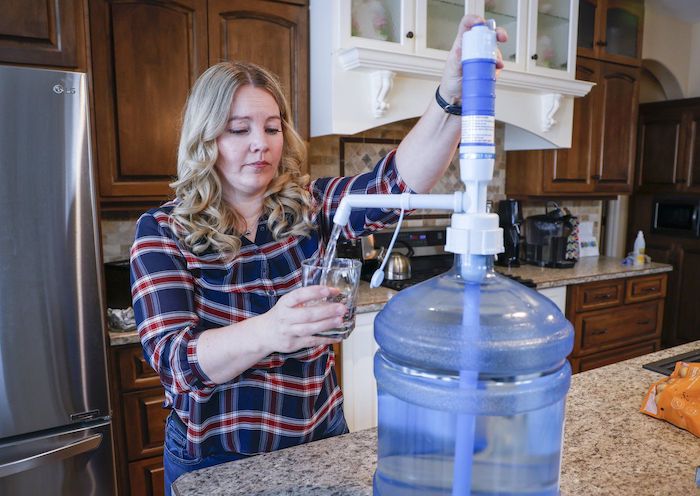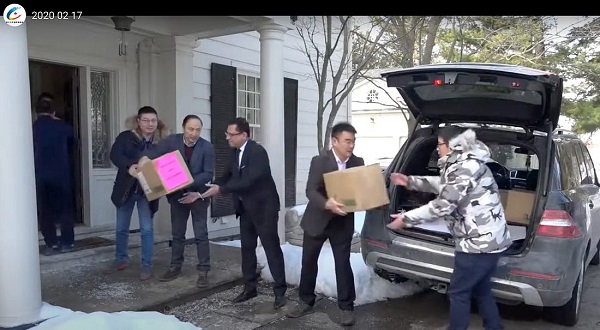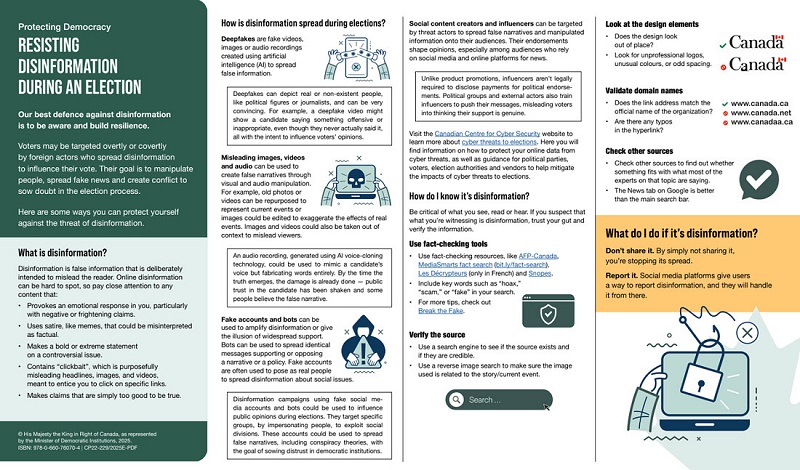Alberta
Alberta investigates Red Deer County family’s lead-contaminated water well near gravel mine

By Bob Weber
Red Deer County – Alberta Environment is investigating how a family’s water well near a gravel mine became so contaminated by lead it’s no longer drinkable.
The investigation comes as Red Deer County considers expanding mine operations that Jody Young suspects are the source of the lead she and her family may have been drinking for months.
“We have it in our blood,” said Young. “My son’s levels are actually higher than mine.”
Young, who lives just south of Red Deer near the banks of the Red Deer River, has lived within a few hundred metres of the county’s gravel mine for more than a decade.
She grew used to the slight murkiness of her once-clear well water as the mines near her central Alberta home stepped up production. Tests a few years ago showed the water was OK and she preferred the tap to a plastic bottle.
But the water kept getting worse.
“We’ve gone from just seeing it in a bathtub to being able to see it in a glass of water,” she said.
So last summer she asked Alberta Health Services to test her family’s well water. Within days, she got a call.
“They told us to immediately stop drinking our water,” she said. “We weren’t to cook with it. We were advised not even to brush our teeth with it.”
Lead — which can cause anemia, weakness, kidney and brain damage — was above levels fit for human consumption. So was aluminum.
Both metals were subsequently found in blood samples from her family.
“It was deeply concerning to learn of well water contamination in Red Deer County,” said Alberta Environment spokeswoman Carla Jones in an email. “The source of these metals is under investigation.”
On Feb. 7, Young plans to appear at a public hearing hosted by Red Deer County to oppose proposed changes to a county land-use bylaw. The changes would permit gravel mines on land virtually adjacent to her water well.
The proposed expansion site, privately owned, is also on land considered environmentally significant by provincial regulators.
“We are in full compliance with Alberta Environment on our pit,” said Dave Dittrick, Red Deer County’s assistant manager. Private operators would have to follow the same regulations, he said.
“Everything they do will have to be in compliance.”
Dittrick said although the county is co-operating with Alberta Environment, it hasn’t seen the data that prompted Alberta Health’s concern.
“We have not seen any information to substantiate these claims,” he said.
Gravel, or aggregate, mines are needed for everything from paving roads to building houses. Although they’re everywhere in Alberta, data on them is hard to find.
Mines larger than five hectares must be registered and come under provincial regulation. Mines that go below the water table or involve significant water use require a Water Act licence.
“Alberta has a robust regulatory approval process to manage environmental impacts of gravel pits,” said Alberta Environment spokesman Miguel Racin.
Smaller mines — the expansion near Young’s well would be about three hectares — are largely regulated by local land-use bylaws.
But observers say such mines are an increasing concern as Alberta continues to grow.
“It’s a problem in every county,” said Vivian Pharis, an environmentalist who has been involved in previous conflicts over such mines.
“We don’t have any good provincial regulations. The primary decision is made at the municipal level and, as soon as the zoning gets changed, then it seems Alberta Environment’s hands are tied.”
Hydrogeologist Jon Fennell, who has consulted on several mine projects, said gravel mines run the risk of exposing and releasing chemicals formerly held stable.
“If you’re opening (a mine) up and exposing things to oxygen, they can weather and oxidize and get mobilized,” he said. “Any time you disturb the earth, things change.”
While municipalities are in charge of much of the gravel mine permitting process, Fennell points out they are also heavy gravel users.
“They’re very pro-gravel in some parts of the province,” he said.
Red Deer County’s previous attempt to expand its aggregate operations near Young’s home was thrown out in 2022 by a Court of King’s Bench judge over an unfair process.
Enforcement is lax even for mines that do come under provincial rules, Fennell said. Operators may be required to monitor water levels, but not water quality.
“It’s not required,” he said. “If you don’t look, you don’t find.”
Gravel mines are necessary, said Dittrick.
“Aggregate is needed for development and development is ongoing,” he said.
Some sources may be more appropriate than others, said Fennell.
“We have to get (gravel) from somewhere. The question is, from where?”
Young wonders how long her family has been drinking lead-contaminated water. And she wonders why she has to wonder about that at all.
“I’ve had some real moments with this,” she said.
She recalls learning about some of her son’s computer searches.
“I found he was Googling about lead poisoning. He was researching potential impacts to himself.”
This report by The Canadian Press was first published Jan. 17, 2023.
Alberta
Made in Alberta! Province makes it easier to support local products with Buy Local program

Show your Alberta side. Buy Local. |
When the going gets tough, Albertans stick together. That’s why Alberta’s government is launching a new campaign to benefit hard-working Albertans.
Global uncertainty is threatening the livelihoods of hard-working Alberta farmers, ranchers, processors and their families. The ‘Buy Local’ campaign, recently launched by Alberta’s government, encourages consumers to eat, drink and buy local to show our unified support for the province’s agriculture and food industry.
The government’s ‘Buy Local’ campaign encourages consumers to buy products from Alberta’s hard-working farmers, ranchers and food processors that produce safe, nutritious food for Albertans, Canadians and the world.
“It’s time to let these hard-working Albertans know we have their back. Now, more than ever, we need to shop local and buy made-in-Alberta products. The next time you are grocery shopping or go out for dinner or a drink with your friends or family, support local to demonstrate your Alberta pride. We are pleased tariffs don’t impact the ag industry right now and will keep advocating for our ag industry.”
Alberta’s government supports consumer choice. We are providing tools to help folks easily identify Alberta- and Canadian-made foods and products. Choosing local products keeps Albertans’ hard-earned dollars in our province. Whether it is farm-fresh vegetables, potatoes, honey, craft beer, frozen food or our world-renowned beef, Alberta has an abundance of fresh foods produced right on our doorstep.
Quick facts
- This summer, Albertans can support local at more than 150 farmers’ markets across the province and meet the folks who make, bake and grow our food.
- In March 2023, the Alberta government launched the ‘Made in Alberta’ voluntary food and beverage labelling program to support local agriculture and food sectors.
- Through direct connections with processors, the program has created the momentum to continue expanding consumer awareness about the ‘Made in Alberta’ label to help shoppers quickly identify foods and beverages produced in our province.
- Made in Alberta product catalogue website
Related information
Alberta
Province to expand services provided by Alberta Sheriffs: New policing option for municipalities

Expanding municipal police service options |
Proposed amendments would help ensure Alberta’s evolving public safety needs are met while also giving municipalities more options for local policing.
As first announced with the introduction of the Public Safety Statutes Amendment Act, 2024, Alberta’s government is considering creating a new independent agency police service to assume the police-like duties currently performed by Alberta Sheriffs. If passed, Bill 49 would lay additional groundwork for the new police service.
Proposed amendments to the Police Act recognize the unique challenges faced by different communities and seek to empower local governments to adopt strategies that effectively respond to their specific safety concerns, enhancing overall public safety across the province.
If passed, Bill 49 would specify that the new agency would be a Crown corporation with an independent board of directors to oversee its day-to-day operations. The new agency would be operationally independent from the government, consistent with all police services in Alberta. Unlike the Alberta Sheriffs, officers in the new police service would be directly employed by the police service rather than by the government.
“With this bill, we are taking the necessary steps to address the unique public safety concerns in communities across Alberta. As we work towards creating an independent agency police service, we are providing an essential component of Alberta’s police framework for years to come. Our aim is for the new agency is to ensure that Albertans are safe in their communities and receive the best possible service when they need it most.”
Additional amendments would allow municipalities to select the new agency as their local police service once it becomes fully operational and the necessary standards, capacity and frameworks are in place. Alberta’s government is committed to ensuring the new agency works collaboratively with all police services to meet the province’s evolving public safety needs and improve law enforcement response times, particularly in rural communities. While the RCMP would remain the official provincial police service, municipalities would have a new option for their local policing needs.
Once established, the agency would strengthen Alberta’s existing policing model and complement the province’s current police services, which include the RCMP, Indigenous police services and municipal police. It would help fill gaps and ensure law enforcement resources are deployed efficiently across the province.
Related information
-

 Daily Caller1 day ago
Daily Caller1 day agoTrump Executive Orders ensure ‘Beautiful Clean’ Affordable Coal will continue to bolster US energy grid
-

 2025 Federal Election1 day ago
2025 Federal Election1 day agoBREAKING from THE BUREAU: Pro-Beijing Group That Pushed Erin O’Toole’s Exit Warns Chinese Canadians to “Vote Carefully”
-

 Business1 day ago
Business1 day agoChina, Mexico, Canada Flagged in $1.4 Billion Fentanyl Trade by U.S. Financial Watchdog
-

 COVID-191 day ago
COVID-191 day agoTamara Lich and Chris Barber trial update: The Longest Mischief Trial of All Time continues..
-

 2025 Federal Election2 days ago
2025 Federal Election2 days agoTucker Carlson Interviews Maxime Bernier: Trump’s Tariffs, Mass Immigration, and the Oncoming Canadian Revolution
-

 Energy1 day ago
Energy1 day agoStraits of Mackinac Tunnel for Line 5 Pipeline to get “accelerated review”: US Army Corps of Engineers
-

 2025 Federal Election1 day ago
2025 Federal Election1 day agoAllegations of ethical misconduct by the Prime Minister and Government of Canada during the current federal election campaign
-

 Business2 days ago
Business2 days agoDOGE Is Ending The ‘Eternal Life’ Of Government






